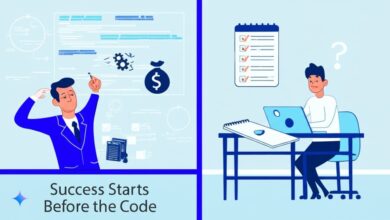
As a SaaS startup, this is common picture: pure excitement, late nights fueled by caffeine and code, the dream of launching something amazing. Like you, that was me.
But somewhere between the initial spark and actually getting things off the ground, I hit… well, let’s just call them “learning opportunities.” Lots of them.
I remember one particularly face-palm moment involving the product name. I’d spent ages brainstorming, finally settled on the one, bought the domain, designed a logo… only to discover a few weeks later that a surprisingly similar service already existed, muddling the search results.
Cue frantic rebranding and feeling like I’d tripped right at the starting line. It wasn’t funny then, but looking back, it’s a classic “oh, rookie me” story.
So, I’ve decided to lay out my stumbles, my missteps, the things I wish someone had shaken me and told me before I started.
This isn’t a list of theoretical problems; this is my real-world, hard-won experience, served up so hopefully, your journey can be a bit smoother.
Key Takeaways from My SaaS Building Blunders
Before we get into the nitty-gritty, here are the big lessons that really hit home for me:
- Foundation First, Always: Skipping crucial early steps like legal setup, thorough market research, and careful naming will bite you later. Trust me.
- Plan, Then Build (Seriously): Jumping straight into coding without solid planning is a recipe for rework and wasted effort. Think like an architect!
- Engage Early and Often: Your waitlist and early users are gold. Talk to them, listen to them, and don’t leave them hanging.
Laying the Groundwork (Or lack thereof!)
Getting the initial steps right sets the stage for everything else. I learned this the hard way.
Mistake #1: Ignoring the Legal Stuff
I honestly didn’t give much thought to legal structures at first. Big mistake. Suddenly, I needed to integrate payment gateways like Stripe or use certain APIs (like Meta’s), and boom – they required a registered legal entity.
- Lesson Learned: Set up an LLC (Limited Liability Company) or a similar entity early. You’ll need it for collecting payments, signing contracts, and accessing specific tools.
- Tip: You can often set up an LLC remotely in the US for around $500 through various online services. It saves headaches down the road.
Mistake #2: Skipping Deep Market Research
I glanced at a few big competitors and thought, “Okay, I see the landscape.” Nope. I kept building, and only months later did I realize just how crowded my niche was, filled with both giants and nimble indie developers. A study by CB Insights often points to “no market need” as a top reason startups fail – while my market existed, I didn’t understand my place in it well enough [1].
- Lesson Learned: Dive deep into market analysis before you commit significant resources.
- Actionable Step:
- Use sites like
AlternativeTo.net. - Search for your top 5-10 perceived competitors.
- Compile all their listed alternatives into a table. This is your real competitive landscape.
- Use sites like
Here’s a simplified example of what that table might look like:
| Competitor | Key Feature 1 | Key Feature 2 | Pricing Model | Target Audience | Unique Angle? |
|---|---|---|---|---|---|
| Big Competitor A | Yes | Limited | Subscription | Enterprise | Scale |
| Small Indie Tool B | No | Yes | One-time | Freelancers | Simplicity |
| Your SaaS Idea | Yes | Yes | ? | Small Businesses? | Customer Service? |
| … (add more) | … | … | … | … | … |
Study this table. Figure out where you genuinely fit or if you need to pivot.
Mistake #3: The Dreaded Domain Name Debacle
As mentioned in my little anecdote, I was careless with my first name choice. Rebranding after three months was painful and reset my SEO efforts completely.
- Lesson Learned: Choose your name very carefully.
- Checklist:
- Is it a “dead name”? (Minimal existing Google results, especially for similar services).
- Are the social media handles available?
- Is it easy to spell and remember?
- Does it clearly hint at what you do (or is it intriguingly brandable)?
- Tip: Brainstorm with ChatGPT, friends, or potential users. Getting outside perspectives helps counter personal bias.
Building, Waiting, and Engaging (The Right Way)
Once the foundation is somewhat stable, the building and initial outreach phase begins. More pitfalls await!
Mistake #4 & #5: The Waitlist Fumbles (Setup & Silence)
Starting a waitlist is smart. Not engaging with it is… not. I set one up but then kept silent for nearly 2.5 months while I built. When I finally reached out? Crickets. The initial excitement had vanished.
- Lesson Learned: Start a waitlist early and engage with it consistently.
- Waitlist Setup Tips:
- Keep the signup simple. Ask for email, maybe first name for personalization.
- Use UTM parameters to track where signups come from.
- Clearly state: target audience, key features (or the problem you solve), how it works (briefly), maybe an FAQ.
- Send an immediate “Welcome” email. This warms up your sending reputation and catches bounced emails.
- Engagement Strategy:
- Send bi-weekly updates (at least). Share progress, mockups, small wins.
- Ask questions, run polls, make them feel involved.
- Promote your waitlist strategically (Reddit, LinkedIn, X/Twitter) – sometimes subtly in relevant discussions, other times directly.
Mistake #6: Forgetting Your First Users
Once you have a Minimum Viable Product (MVP) and a few brave souls using it, they become incredibly important. Don’t just launch and hope; talk to them.
- Lesson Learned: Engage deeply with your first ~5 users.
- Actions:
- Listen actively to their feedback.
- Ask how they are using the product. What’s working? What’s frustrating?
- Ask for improvement ideas.
- Check in periodically.
- Why? These early users can become your biggest cheerleaders and provide invaluable insights. The Nielsen Norman Group emphasizes that user feedback is critical for iterative design [2]. Consider offering them a lifetime free or heavily discounted plan for their early faith.
Tech Choices & Development Pitfalls
The actual building process is where many technical mistakes happen. I made my share.
Mistake #7: Letting Ego Choose the Tech Stack
I chose frameworks I liked (Vue/Nuxt) without fully considering the ecosystem. While powerful, I found the community support less extensive than for other options, which cost me time when I hit roadblocks.
- Lesson Learned: Put ego aside. Choose proven technologies that have strong community support, good documentation, and solve your current problems effectively.
Mistake #8: SEO Nightmare – The Landing Page
Having the landing page tightly coupled with the main application initially seemed fine. But for SEO, it wasn’t ideal. I lost a week separating them later to implement Server-Side Rendering (SSR) properly for the marketing site.
- Lesson Learned: Consider using an SSR framework (like Next.js, Nuxt.js, SvelteKit, Astro) for your landing page/marketing site from the start for better SEO performance.
Mistake #9: When Hosting Goes Wrong
I initially hosted my backend on Fly.io. It turned out to be incredibly slow for my needs, forcing me to spend several days migrating everything to Render.com.
- Lesson Learned: Choose proven and reliable hosting providers. Evaluate based on performance, scalability, ease of use, and cost relevant to your specific application needs.
Mistake #10: Starting the SEO Game Too Late
SEO isn’t something you just switch on at launch. Domain authority takes time to build.
- Lesson Learned: Start basic SEO activities early, even during the waitlist or MVP phase.
- Early Actions:
- Submit your waitlist/MVP landing page to relevant directories.
- Start writing high-quality, helpful blog content related to the problems your SaaS solves. Optimize your landing page content.
- Ensure your site is technically sound (fast loading, mobile-friendly).
Mistake #11: Coding Before Planning
In the rush to build, I often jumped into coding features without fully thinking through the architecture or data model. This led to weeks of refactoring later. As software engineering principles suggest, good design upfront reduces long-term costs [3].
- Lesson Learned: Think like an architect. Plan before you code extensively.
- Process:
- Think: Understand the problem and the user journey.
- Plan: Design the overall architecture. Crucially, map out your data models carefully. How will information be stored and relate to other pieces of information?
- Build: Code to validate ideas or build core components based on your plan. AI can write code, but it can’t design your vision.
Mistake #12: Wasting Time on MVP UI
I obsessed over the user interface for the first version. It really didn’t matter as much as I thought.
- Lesson Learned: For an MVP, the UI needs to be clean, simple, and functional. Don’t over-polish it. You’ll likely change it later based on user feedback anyway. Focus on solving the core problem first.
Mistake #13: Reinventing the Wheel (Hello, Stripe Billing!)
I spent five days building a custom billing portal. Then I discovered Stripe offered a perfectly good customer portal out-of-the-box that took me less than two hours to integrate. Ouch.
- Lesson Learned: Before building custom components (especially for common functions like billing, authentication, analytics), aggressively look for existing out-of-the-box solutions or third-party services. Your development time is precious.
The Overarching Theme
If there’s one thread connecting many of these mistakes, it’s this:
Mistake #14: Forgetting to Simplify
As you build, your backlog grows. Ideas multiply. It’s easy to get overwhelmed and try to do too much.
- Lesson Learned: Constantly ask yourself: “How can I simplify this?” Focus relentlessly on solving one specific problem exceptionally well for your target audience.
- Rule of Thumb: When facing a dilemma, the simplest solution is often the right one, probably 80% of the time. Look for shortcuts (like using existing tools – Mistake #13) whenever possible. Stay razor-sharp on your core value proposition.
Final Thoughts
Building a SaaS is an incredible journey, full of challenges and triumphs.
Making mistakes is inevitable, even part of the learning process.
But knowing where others have tripped up can save you valuable time, money, and sanity.
My hope is that by sharing my “NO-BS” list of blunders – from foundational gaps to technical missteps and engagement errors – you can navigate your own SaaS adventure with a little more foresight.
Focus on solid groundwork, thoughtful planning, genuine user engagement, and the power of simplification.
If any of these resonated with you, or if you have your own hard-won lessons to share, I’d love to hear about them! What do you wish you knew before launching?
Sources:
- CB Insights. ( frequentemente atualizado ). “The Top Reasons Startups Fail.” CB Insights Research. [While specific links change, searching this title yields their latest report on startup failure analysis, often citing ‘no market need’.]
- Nielsen Norman Group. ( various articles ). Articles on usability testing and iterative design. For example, Budiu, R. (2017). “Iterative Design: Optimize Your Product Through Continuous Improvement.” Nielsen Norman Group.
- McConnell, S. (2004). Code Complete: A Practical Handbook of Software Construction. Microsoft Press. [Chapter 5 discusses the importance of design in construction.]






